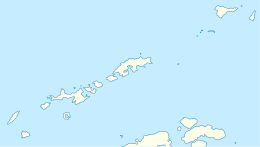 Location of Livingston Island in the South Shetland Islands | |
| Geography | |
|---|---|
| Location | Antarctica |
| Coordinates | 62°33′57″S 61°08′52″W / 62.56583°S 61.14778°W |
| Archipelago | South Shetland Islands |
| Area | 0.08 ha (0.20 acres) |
| Length | 65 m (213 ft) |
| Width | 37 m (121 ft) |
| Administration | |
| Administered under the Antarctic Treaty | |
| Demographics | |
| Population | uninhabited |

Sisson Rock (Bulgarian: скала Сисън, romanized: skala Sisson, IPA: [skɐˈla ˈsisən]) is the rock off the north coast of Livingston Island in the South Shetland Islands, Antarctica 65 m (213 ft) long in west-east direction and 37 m (121 ft) wide, and split in three. Its surface area is 0.08 ha (0.20 acres). The vicinity was visited by early 19th century sealers.[1]
The feature is named after Jonathan Sisson (1690–1747), a British instrument maker who invented the modern theodolite; in association with other names in the area deriving from the early development or use of geodetic instruments and methods.

